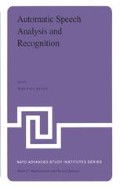Abstract
A method for speaker independent connected word recognition is described. Speaker independence is achieved by clustering isolated word utterances of a 100 speaker population. Connected word recognition is based on a syntax-directed dynamic programming algorithm which matches the isolated word templates to sentence length utterances. The method has been tested on a task oriented English-like language based on a 127 word vocabulary. Four subjects, two men and two women, spoke a total of 209 sentences comprising 1750 words. At an average speaking rate of 171 words per minute over dialed-up telephone lines, a correct word recognition rate of 97% was observed.
Access this chapter
Tax calculation will be finalised at checkout
Purchases are for personal use only
Preview
Unable to display preview. Download preview PDF.
References
Rabiner, L. R., “On Creating Reference Templates for Speaker Independent Recognition of Isolated Words,” IEEE Trans. ASSP, ASSP-26(3), pp. 34–42, 1978.
Itakura, F., “Minimum Prediction Residual Principle Applied to Speech Recognition,” IEEE Trans. ASSP, ASSP-23(1), pp. 67–72, 1975.
Levinson, S. E., Rabiner, L. R., Rosenberg, A.E. and Wilpon, J. G., “Interactive Clustering Techniques for Selecting Speaker Independent Reference Templates for Isolated Word Recognition,” IEEE Trans. ASSP, ASSP-27(2), pp. 134–141, 1979.
Ball, G. H. and Hall, D. J., “Isodata, an Interactive Method of Multivariate Analysis for Pattern Classification,” Proc. IFIPS Congress, 1965.
Rabiner, L. R., Levinson, S. E., Rosenberg, A.E. and Wilpon, J. G., “Speaker Independent Recognition of Isolated Words Using Clustering Techniques,” IEEE Trans. ASSP, ASSP-27(4), pp. 336–349, 1979.
Rabiner, L.R. and Wilpon, J. G., “Considerations in Applying Clustering Techniques to Speaker Independent Word Recognition,” J. Acoust. Soc. Am., 66(3), pp. 663–673, 1979.
Rabiner, L.R. and Wilpon, J. G., “Speaker Independent Isolated Word Recognition for a Moderate Size (54 Word) Vocabulary,” IEEE Trans. ASSP, ASSP-27(6), pp. 583–587, 1979.
Wilpon, J. G., Rabiner, L. R. and Bergh, A., work in progress.
Levinson, S. E., “The Effects of Syntactic Analysis on Word Recognition Accuracy,” Bell. Sys. Tech. J., 57(5), pp. 1627–1645, 1978.
Rabiner, L.R. and Wilpon, J. G., “A Simplified Robust Training Procedure for Speaker Trained Isolated Word Recognition Systems,” J. Acoust. Soc. Am., 68(5), pp. 1271–1276, 1980.
Levinson, S. E., Rosenberg, A.E. and Flanagan, J. L., “Evaluation of a Word Recognition System Using Syntax Analysis,” Bell. Sys. Tech. J., 57(5), pp. 1619–1626, 1978.
Velichko, V. M. and Zagoruiko, N. G., “Automatic Recognition of 200 Words,” Int. J. Man-Machine Studies, 2, p. 223, 1970. There seems to be work by Russian investigators which predates this study. Several obscure references are given by Zagoruiko in a bibliographical paper entitled “Automatic Recognition of Acoustic Patterns the Problem State Review” which was to have appeared in the Procedings of the 5th International Conference on Pattern Recognition but arrived too late for inclusion in that volume. Copies were distributed at the conference and reprints may be available from the International Association for Pattern Recognition or the IEEE Computer Society.
Sakoe, H. and Chiba, S., “A Similarity Evaluation of Speech Patterns by Dynamic Programming,” Digest of the 1970 National Meeting of IECEJ, 1970.
Sakoe, H. and Chiba, S. “A Dynamic Programming Approach to Continuous Speech Recognition,” Proc. 7th ICA, 1971.
Sakoe, H. “Two-level DP Matching — A Dynamic Programming Based Pattern Matching Algorithm for Connected Word Recognition,” IEEE Trans. ASSP, ASSP-27(6), pp. 588–595, 1979.
Bridle, J. S. and Brown, M. D., “Connected Word Recognition Using Whole Word Templates” Proc. Inst. Acoust. Autumn Conf., 1979.
Rabiner, L. R., Rosenberg, A.E. and Levinson, S. E., “Considerations in Dynamic Time Warping for Discrete Word Recognition,” IEEE Trans, ASSP, ASSP-26(6), pp. 575–582, 1978.
Rabiner, L. R. and Schmidt, C. E., “Application of Dynamic Time Warping to Connected Digit Recognition,” IEEE Trans. ASSP, ASSP-28(4), pp. 377–388, 1980.
Myers, C. S. and Rabiner, L. R., “Connected Digit Recognition Using a Level Building DTW Algorithm” IEEE Trans. ASSP, in press.
Myers, C.S. and Rabiner, L. R., “A Level Building Dynamic Time Warping Algorithm for Connected Word Recognition,” IEEE Trans. ASSP, ASSP-29(2), pp. 284–296, 1981.
Levinson, S. E. and Rosenberg, A. E., “A New System for Continuous Speech Recognition — Preliminary Results,” Proc. ICASSP-79, pp. 239-243, 1979.
Levinson, S. E. and Rosenberg, A. E., “Some Experiments with a Syntax-Directed Speech Recognition System,” Proc. ICASSP-78, pp. 409-412, 1978.
Myers, C. S. and Levinson, S. E., “Connected Word Recognition Using a Syntax-Directed Dynamic Programming Temporal Alignment Procedure,” Proc. ICASSP-81, pp.956-959, 1981.
Sondhi, M. M. and Levinson, S. E., “Computing Relative Redundancy to Measure Grammatical Constraint in Speech Recognition Tasks,” Proc. ICASSP-78, pp. 409-412, 1978.
Levinson, S.E. and Shipley, K. L., “A Conversational Mode Airline Information and Reservation System Using Speech Input and Output,” Bell Sys. Tech. J., 59(1), pp. 119–137, 1980.
Ackenhusen, J. G. and Rabiner, L. R., “Microprocessor Implementation of an LPC Based Word Recognizer,” Proc. ICASSP-81, pp. 746-749, 1981.
Rosenberg, A. E., Rabiner, L. R., Levinson, S. E. and Wilpon, J. G. “A Preliminary Study on the Use of Demisyllables in Automatic Speech Recognition,” Proc. ICASSP-81, pp. 967-970, 1981.
Author information
Authors and Affiliations
Editor information
Editors and Affiliations
Rights and permissions
Copyright information
© 1982 D. Reidel Publishing Company, Dordrecht, Holland
About this paper
Cite this paper
Levinson, S.E. (1982). Speaker Independent Connected Word Recognition. In: Haton, JP. (eds) Automatic Speech Analysis and Recognition. NATO Advanced Study Institutes Series, vol 88. Springer, Dordrecht. https://doi.org/10.1007/978-94-009-7879-9_10
Download citation
DOI: https://doi.org/10.1007/978-94-009-7879-9_10
Publisher Name: Springer, Dordrecht
Print ISBN: 978-94-009-7881-2
Online ISBN: 978-94-009-7879-9
eBook Packages: Springer Book Archive

